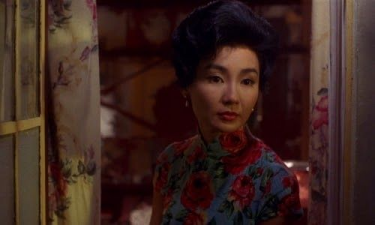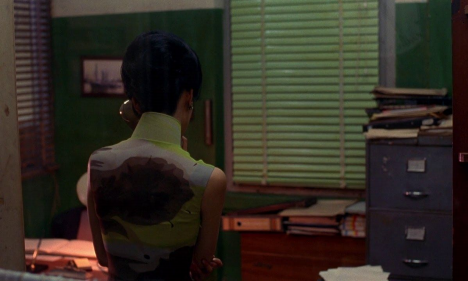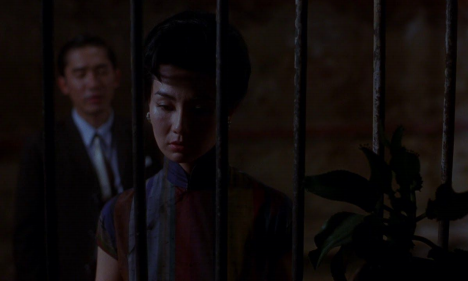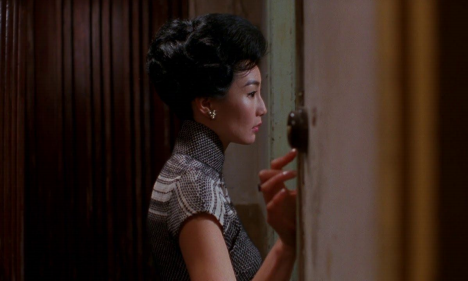Using Costume to Tell a Story in ‘In the Mood For Love’
January 10, 2021
If the stars of Wong Kar-Wai’s In the Mood for Love spent the film wearing unremarkable outfits, it would merely be a film about a mildly torrid and frustratingly unrelatable affair. Instead, it is a film about the very essence of heartbreak and desire.
When we meet Su Li-zhen (Maggie Cheung), she is wearing a pale blue cheongsam adorned with vibrant flowers. One defining feature of Su, (which other characters in In the Mood for Love don’t let us forget), is that she stands out, and this bombshell introductory outfit perfectly conveys that fact. She gets dressed up in her finest attire to buy noodles around the corner. She wears neons and explosive patterns when those around her don monochromes.
Indeed, one can tell a great deal about a person from the clothes they wear, but perhaps even more so from the way their clothing relates to those around them, as well as their inanimate surroundings. While Su is styled intentionally to stand out, she also matches her surroundings on multiple occasions. Take, for instance, her aforementioned debut blue dress. Su wears it to rent a room, and it matches the curtains in her new home. Later in the film, when she wears a green dress with white geometric patterns, she matches the wallpaper, and, in a later brown dress, while eating dinner with Chow Mo-wan (Tony Leung), matches the wallpaper once again.
When we meet Su Li-zhen (Maggie Cheung), she is wearing a pale blue cheongsam adorned with vibrant flowers. One defining feature of Su, (which other characters in In the Mood for Love don’t let us forget), is that she stands out, and this bombshell introductory outfit perfectly conveys that fact. She gets dressed up in her finest attire to buy noodles around the corner. She wears neons and explosive patterns when those around her don monochromes.
Indeed, one can tell a great deal about a person from the clothes they wear, but perhaps even more so from the way their clothing relates to those around them, as well as their inanimate surroundings. While Su is styled intentionally to stand out, she also matches her surroundings on multiple occasions. Take, for instance, her aforementioned debut blue dress. Su wears it to rent a room, and it matches the curtains in her new home. Later in the film, when she wears a green dress with white geometric patterns, she matches the wallpaper, and, in a later brown dress, while eating dinner with Chow Mo-wan (Tony Leung), matches the wallpaper once again.
Though the wallpapers and curtains that Su’s clothing attach her to are seemingly insignificant, they work, at first, to emphasise the isolation she experiences day-to-day. Su lives with her husband, but she essentially lives alone. We never see his face, and he is constantly away on business trips. He is shrouded in mystery and anonymity and almost serves as a place-holder; a projection of a standard domestic partnership. Su is lonely. It seems that her only friends are her neighbours, who are much older than her and with whom she has nothing in common. As a result, she is in a constant state of yearning; she is in the mood for love, or something of the likes.
But everything changes when she meets her next-door neighbour, journalist Chow. Though the words they share are few and far between, they instantly find kinship in one another. And Wong Kar Wai presents this fact through their clothing. Initially, it even brings them together on a thematic level. The two figure out they are being cheated on by their spouses because of Chow’s tie, which comes from the same place Su’s husband buys his tie. Su’s handbag is also suspiciously similar to Chow’s wife’s brand new accessory. After just a couple benign, polite inquiries, they are forever bound together by infidelity and accessories. The realisations about their accessories are never said outright, but merely implied – the clothing itself does much more of the talking than the characters ever can.
But everything changes when she meets her next-door neighbour, journalist Chow. Though the words they share are few and far between, they instantly find kinship in one another. And Wong Kar Wai presents this fact through their clothing. Initially, it even brings them together on a thematic level. The two figure out they are being cheated on by their spouses because of Chow’s tie, which comes from the same place Su’s husband buys his tie. Su’s handbag is also suspiciously similar to Chow’s wife’s brand new accessory. After just a couple benign, polite inquiries, they are forever bound together by infidelity and accessories. The realisations about their accessories are never said outright, but merely implied – the clothing itself does much more of the talking than the characters ever can.
The deeper the two fall into their affair, the more the colour schemes and patterns of their clothing fall into sync. Later, when Chow is no longer around, Su has no one to match with, physically or emotional. Therefore, Wong reverts to matching her to her surroundings. But, unlike before meeting Chow, these echoes symbolise something more than mere isolation. When in Chow’s room and feeling his absence deeply, Su matches his wallpaper. This colour scheme binds her to a place where she has loved – and will never love again. “I miss you” is never uttered. It is implicit in the textures and colours within the frame. That era has passed, as reads a title card later in the film. Nothing that belonged to it exists anymore. And, for Su, that is painfully true – the only relic she has left to hang on to her companion is her own dress.
And, as with the themes of In the Mood for Love unfold, so do Su’s dresses proliferate to reflect that. When she borrows a newspaper from Chow, she wears a white cheongsam with black polka dots. The white reflects a sweetness and a softness; the polka dots a childlike innocence. She is in the beginning stages of her romance, and white dresses and chiffons highlight her delicate nature.
And, as with the themes of In the Mood for Love unfold, so do Su’s dresses proliferate to reflect that. When she borrows a newspaper from Chow, she wears a white cheongsam with black polka dots. The white reflects a sweetness and a softness; the polka dots a childlike innocence. She is in the beginning stages of her romance, and white dresses and chiffons highlight her delicate nature.
It is not long before Chow and Su’s relationship becomes complicated, and Su’s cheongsams rapidly shift to mirror the complex themes. Once, for example, when Su learns about a quarrel between Chow and his wife, she wears dark green to symbolise the jealousy she feels over their marital troubles. She wears deep red, too, when it is hinted that she is seducing Chow – which is, perhaps, the most overt of the colour themes in In the Mood for Love.
On a first watch of In the Mood for Love, the film might seem to prioritise style over substance. Indeed, Wong Kar-Wai has been critiqued for favouring a flashy frame over the film’s content. But, for In the Mood for Love, Maggie Cheung’s iconic twenty-three dresses serve more than just a beautiful and impressive feat. In fact, they are more important than the script itself. In the film’s era, Hong Kong in 1962, women expressing their emotions was still considered taboo. Although women were joining the workforce in large numbers at this time, they were expected to remain silent and polite. That is why, if one were to simply read the screenplay for In the Mood for Love, much of the story might be missed, and the plot might seem empty. Where words fall short, a different method of storytelling must be employed. So, instead, Wong Kar-Wai adorns his heroine in ethereal cheongsams, and, through that, tells a rich and detailed story of a year in love and loss.
On a first watch of In the Mood for Love, the film might seem to prioritise style over substance. Indeed, Wong Kar-Wai has been critiqued for favouring a flashy frame over the film’s content. But, for In the Mood for Love, Maggie Cheung’s iconic twenty-three dresses serve more than just a beautiful and impressive feat. In fact, they are more important than the script itself. In the film’s era, Hong Kong in 1962, women expressing their emotions was still considered taboo. Although women were joining the workforce in large numbers at this time, they were expected to remain silent and polite. That is why, if one were to simply read the screenplay for In the Mood for Love, much of the story might be missed, and the plot might seem empty. Where words fall short, a different method of storytelling must be employed. So, instead, Wong Kar-Wai adorns his heroine in ethereal cheongsams, and, through that, tells a rich and detailed story of a year in love and loss.





